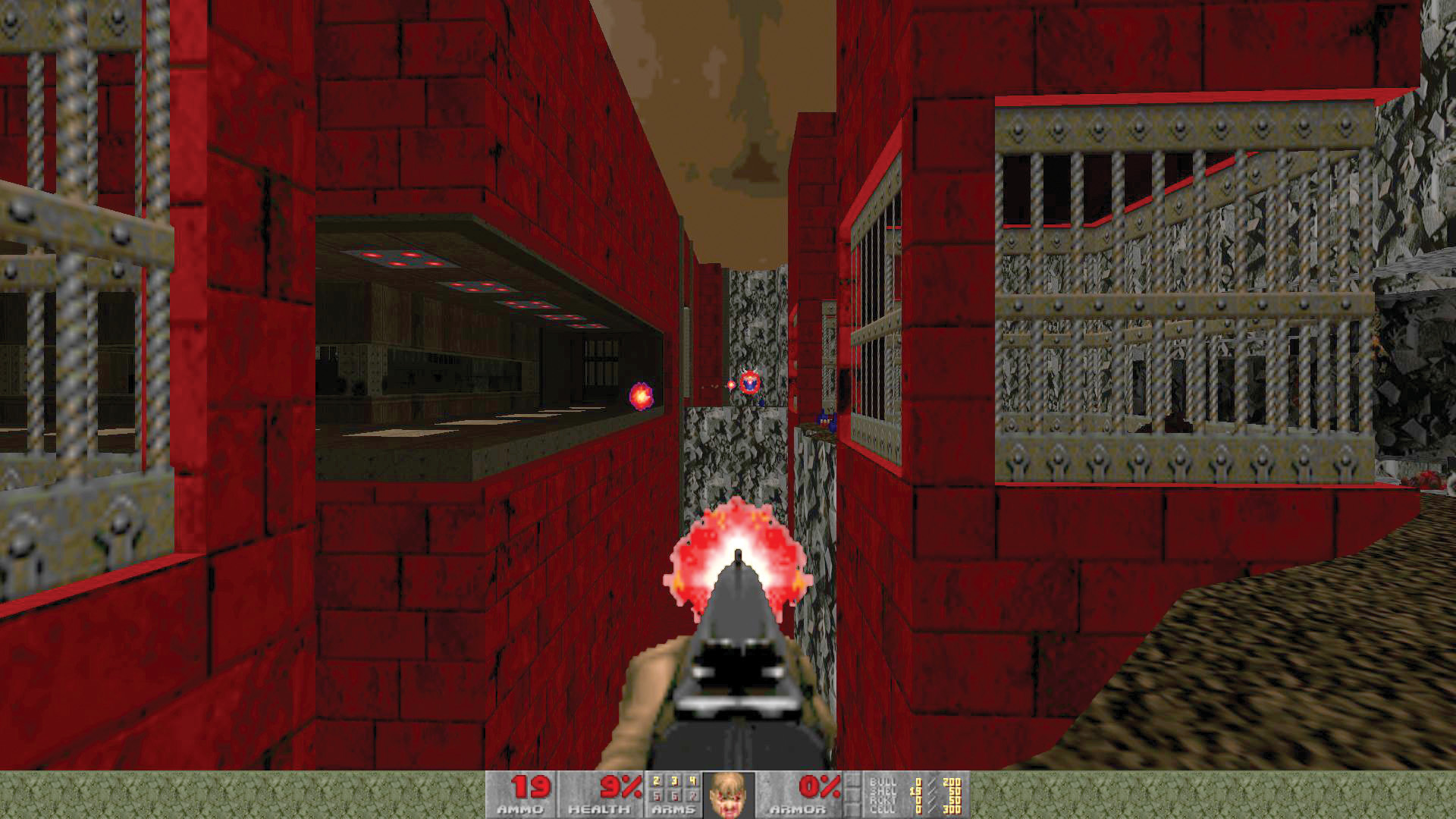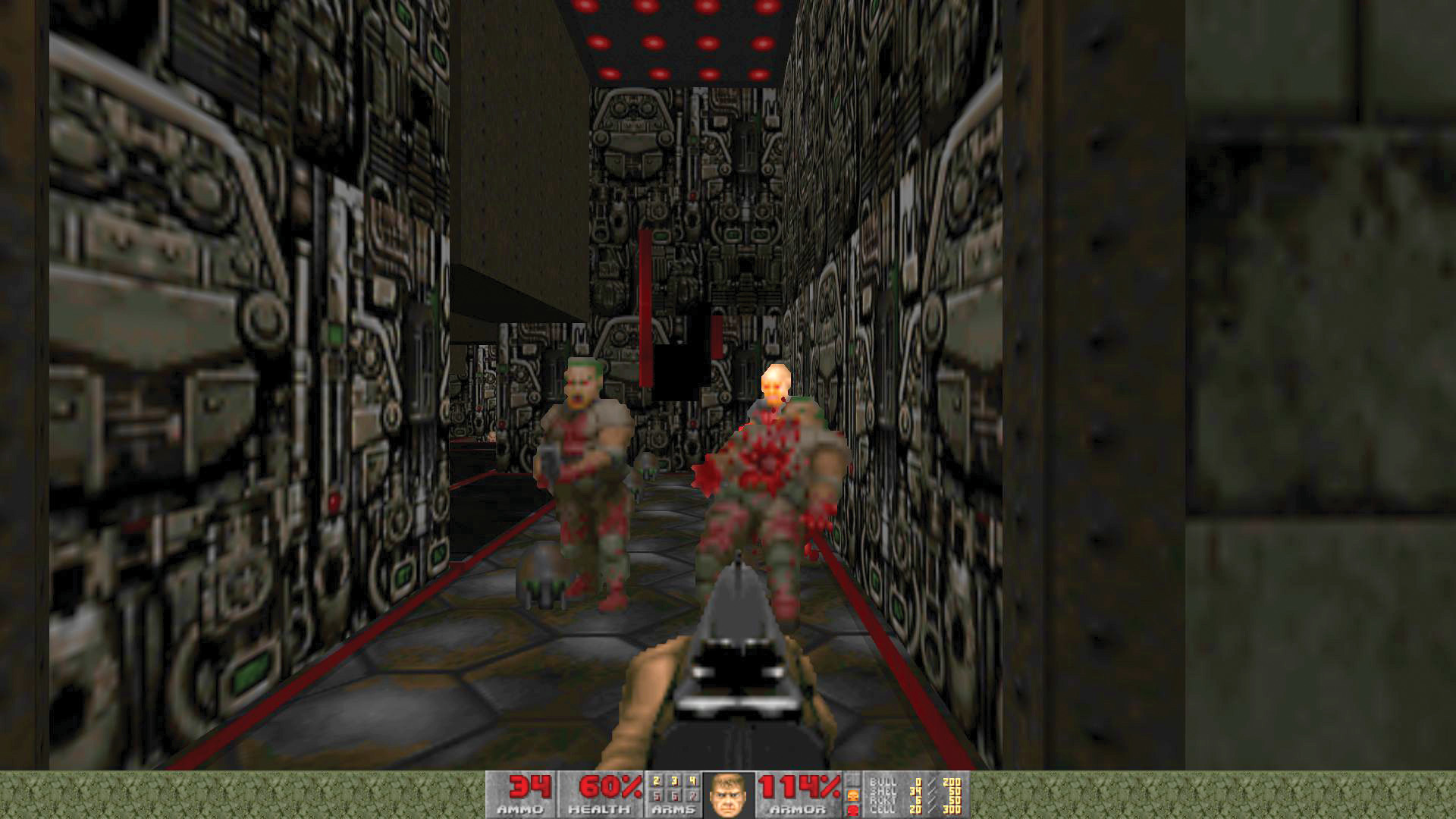Romero returns to Doom to play tricks in Sigil
Darkness and traps pile on the pressure.

Has John Romero forgotten how to put lights into Doom levels? Nobody’s going to hold it against him if he has—it’s been 25 years since Doom 2, after all. Perhaps he could make an anonymous account on the Doomworld forums if he’s embarrassed. It’s just that I’ve spent a sunny afternoon squinting around in the dark of Sigil, Romero’s new fifth episode for Ultimate Doom, feeling out pathways over lava I can’t see.
It feels a little perverse that the only episode Doom’s designer has made in the full-fledged internet age is one where visual information is so hard to come by, and confusion the defining theme. But there’s a lot about Sigil that’s wilfully backward.
Andy dug into Total Chaos previously, a Doom 2 mod which, to the untrained eye, could pass for a contemporary survival horror game. That’s indicative of the transformative advancements amateur tinkerers have made with the Doom engine over two and a half decades. But Sigil eschews all that, instead reverting to the game as it was at the close of Ultimate Doom—as if Romero had simply carried on making levels in ’95. Nonetheless, these are his most visually striking adventures in Doom to date. Brightly coloured assets, spotlit by candelabra in the pitch blackness, give Sigil the aesthetic of theatre. And some of its prop placement has stuck with me—like the Cacodemon hidden through a letterbox in a wooden maze, invisible in the dark until illuminated by its own fireball.
Dark room
Doom has always played with light, but Romero’s commitment to high contrast environments in the early part of Sigil changes what that means. I’ve become accustomed to targeting enemies by silhouette—a practice that demonstrates the strength of decades-old monster design in, well, black and white terms. The broad shoulders and horns of the Baron of Hell ensure you’ll never mistake it for an Imp, and the looming curve of a Cacodemon is distinct from that of a Lost Soul, whatever the distance.
In the dark, the game’s audio cues become all-important too—did that Zombieman make his damage roar just now, or his death moan? There’s a crucial pitch distinction there that could mean life or death in an episode where health packs are doled out with cruel infrequency.
Often I find myself funnelled down pathways with just the barest indication of where the floor is—edging blindly towards flickering light, wary of another frustrating fall through fissures in the earth. In the worst culprit, the narrow deathtrap of Sheol, Romero mercifully punctuates the lava below with flaming teleporters that act as beacons, a distant chance at survival. It’s a similar story at the level exit, where there’s often a beefy enemy guarding the gate—lethal at low health, but if you can circumvent them, you might just make it.

Unlike levels in modern shooters, their personalities necessarily diluted by the sheer number of hands that touch them, it’s impossible to play Sigil without thinking constantly of the designer behind it. There are times it feels as if I’ve been tricked by a Loki-like puppeteer, as when Romero spawns a Shotgun Guy directly behind me just as I press a button. Then, as the monster crumbles into gibs, a stimpack reveals itself in a nook behind the body—almost like an apology. This is shooter level design at its most human, for better and worse.
The biggest gaming news, reviews and hardware deals
Keep up to date with the most important stories and the best deals, as picked by the PC Gamer team.
At Sigil’s lowest moments, it feels as if I’m learning the way through each level by rote, rather than standing any chance of reacting to what’s being thrown at me in real-time. A chapter rarely takes more than five minutes in total, but many more than that in trial and error. They’re arguably more fun to play through a second time, when you know the route and can appreciate their trickiness as an insider.
Sigil me this
Those outside the games industry often make the mistake of assuming developers play games all day, but in Romero’s case, that’s halfway true. During level design he tests his creation over and over, making minute tweaks to rooms or planting some new hazard before hurling himself back into hell.
Playing Sigil, I’ve discovering the levels piece by piece, with liberal use of the quicksave and quickload keys—an almost parallel pattern to their design process.
Shooters tend to hide their boundaries, but I like the moments where Romero asks me to mess with Doom’s rules. When he plants shotgun shells on a small patch of lava, it’s a prompt for me to test the limits—knowing that it’ll be a couple of seconds before burning damage kicks in. And the dead marine next to those bullets is a reminder of what’ll happen if I overestimate my knowledge.

Like all megawads—sets of Doom levels substantial enough to be considered campaigns—Sigil is free. But you can pay extra for access to the soundtrack from Buckethead, who played guitar in Guns ‘n’ Roses during the recording of Chinese Democracy. And, while I’m explaining ’90s things, you can get extra enjoyment out of a tape by holding down the play button midway to hear the track at double speed.
Buckethead’s virtuosic riffing make a fitting follow-up to the MIDI-metal of the original Doom, and his accompaniment helps distinguish Sigil from its predecessors in the mind—a soundtrack as spiky and changeable as the levels themselves. It also reflects the shifting mood of Sigil, from the frenzied opening to a more considered pace. By Abbadon’s Void, the episode midpoint that sets a backdrop of tall towers and red lightning against a lava lake, the riffs have given way to Vangelis-style synthwork and discordant stabs of sound.
Sigil is home to many tight and twisting trails. But as Romero lets colour seep back into his realm deeper into the campaign, the walls start to come down—literally. Buttons and keys open doors, as expected, but they also reshape huge chunks of the architecture.
Romero delights in lifting up the box that contains the player and letting them blink in the light. Cages of the Damned starts as a corridored affair, but each push of a switch—the face of a laughing gargoyle—gradually transforms indoors to outdoors. In the wide-open hellscape left behind, combat is different too. Using an insta-hit weapon such as the shotgun, I can kill a cacodemon long before its projectile reaches me, like the light from a dead star.
Those slow fireballs, incidentally, are one of the elements that still make Doom a pleasure distinct from today’s shooters. When a near-miss causes me to dodge at my keyboard, I start to see the trajectory that led John Carmack to VR.

Fitting, then, that all this on-the- fly landscaping builds to a truly nauseating sequence—a mechanical cavern where segmented platforms move up and down out of sync, while huge crushers descend from the ceiling. Navigating them is like swimming out on a sea of steel in search of a life raft. Killing the guards and taking their safe spots is the only way to make it through.
It’d be strange to describe any of this as innovation—this mod is a throwback above anything else. But there’s a sense that Romero is having fun with the tools, exploring ideas and developing themes. Structure is a common source of experimentation—in Paths of Wretchedness, a Greco-Roman vision of the underworld, there are keys at the end of three different paths. At the close of each one, you teleport back to the start and pick another. More than once in Sigil I’ve found myself looking back out onto an area I already know from a new perspective, like a Dark Souls player first exploring Lordran.
Shooting switches
Throughout, the sigil of the title is a regular motif—a bright occult mark on the wall, in the centre of which sits a huge eye. It looks, frankly, daft by today’s artistic standards. But there’s something about its implementation. When you get stuck, the mod trains you to look about—and more often than not, there is the eye, watching from between the cracks in the basalt of hell. To reveal the way forward, you must shoot it—causing a tunnel to open, or a new bridge to rise up from a molten pool.
That act feels, to me, like an acknowledgement of the huge presence of the designer in Sigil—and in Doom levels as a whole, where a single eye shapes the world. Romero may have vacated the editor long before I stepped into his levels, but it feels as if he’s still there watching—the devious stagehand pulling at levers, playing with my head, and most of all, having a tremendous time doing it.
Jeremy Peel is an award-nominated freelance journalist who has been writing and editing for PC Gamer over the past several years. His greatest success during that period was a pandemic article called "Every type of Fall Guy, classified", which kept the lights on at PCG for at least a week. He’s rested on his laurels ever since, indulging his love for ultra-deep, story-driven simulations by submitting monthly interviews with the designers behind Fallout, Dishonored and Deus Ex. He's also written columns on the likes of Jalopy, the ramshackle car game. You can find him on Patreon as The Peel Perspective.

